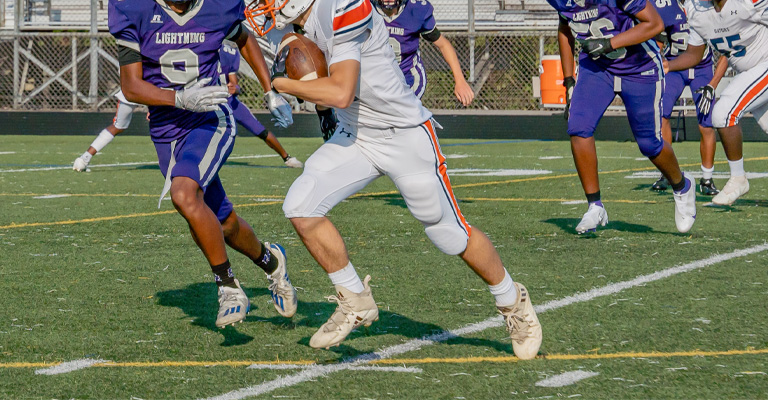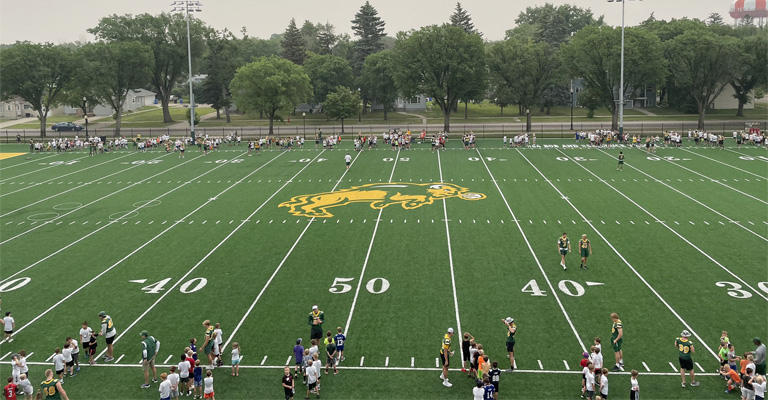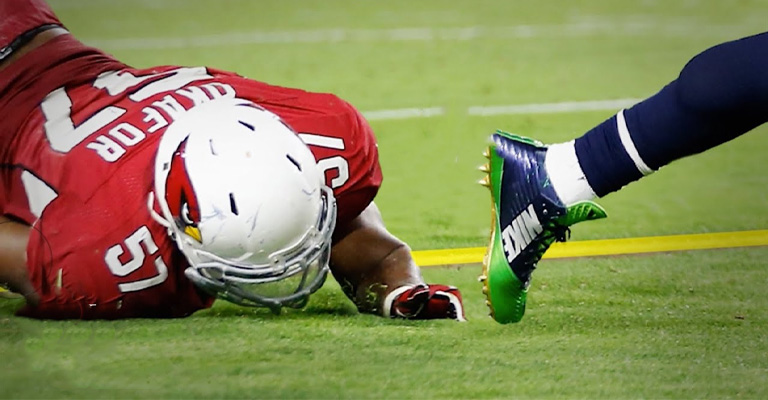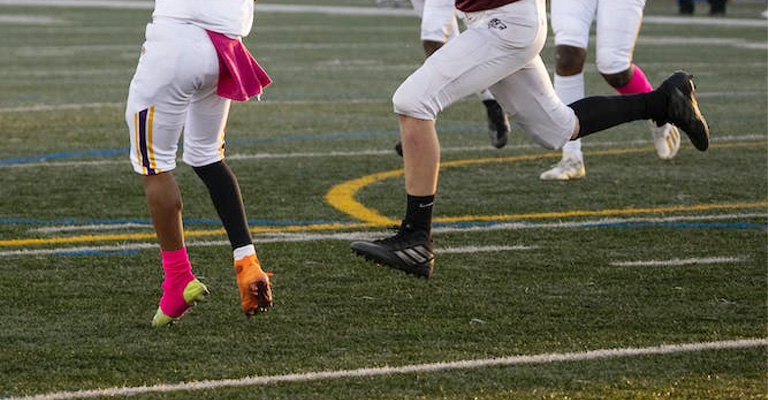In the dynamic world of American football broadcasts, there’s a ubiquitous yet intangible element that adds both clarity and mystique to the viewing experience—the yellow line.
Unseen on the actual field but ever-present on our screens, this digital marvel represents a pivotal aspect of football comprehension. Originating as “1st & Ten” in 1998, the yellow line is a product of Sportvision’s technological prowess.
Using chroma key technology and real-time data, it dynamically mirrors the line to gain a first down, simplifying the intricacies of the game for millions of viewers.
In this exploration, we unravel the magic behind the yellow line, understanding its inception, technological workings, and its profound impact on how we engage with the gridiron spectacle.
What Is The Yellow Line In Football?
In American football, the yellow line is a visual aid used in television broadcasts to indicate the distance a team needs to cover in order to achieve a first down.
It is not physically present on the field but is digitally superimposed on the screen. The line is positioned parallel to the line of scrimmage and changes its placement based on the current down and distance.
The purpose of the yellow line is to provide viewers with a clear and instant understanding of the offensive team’s goal and the yards they must gain for a new set of downs.
This innovative technology enhances the viewer’s experience by simplifying the complex nature of football strategies and measurements.
Origins of Yellow Line In Football

The yellow line in American football originated as a technological innovation known as “1st & Ten.” Sportvision, a sports technology company, introduced this system in 1998.
The goal was to enhance the viewing experience for television audiences by providing a clearer visual representation of the line to gain for a first down.
Chroma Key Technology
The yellow line is created using chroma key technology.
The process involves identifying the field of play, isolating the players and other objects, and overlaying a digitally generated yellow line that remains consistently positioned relative to the first-down marker on the field.
Real-Time Calculations
The yellow line adjusts in real-time based on the line of scrimmage and the yards needed for a first down.
This requires precise calculations and coordination between the broadcast equipment and the live action on the field.
Enhanced Fan Understanding
The introduction of the yellow line revolutionized football broadcasting, providing fans with an intuitive and instant understanding of the game situation.
It simplified the complex measurement aspects of football, making it more accessible and engaging for viewers.
The yellow line has since become a standard feature in televised football broadcasts, illustrating its success in enhancing the sport’s visual presentation.
How Does Yellow Line Work?

The yellow line in American football is a visual enhancement created through a technology known as chroma keying. Here’s how it works:
Chroma Key Technology
The process begins with the use of chroma key technology, commonly referred to as “green screen” or “blue screen” technology. In football broadcasts, a shade of green is often used for this purpose.
The field of play is filmed, and the areas with a specific shade of green (not present in the players’ uniforms or the natural elements on the field) are designated as areas where the virtual graphics will be inserted.
Data Integration
Data about the current line of scrimmage and the distance needed for a first down is collected in real-time from the game.
This data is then processed and integrated into the broadcast system.
Overlaying the Yellow Line
Using the chroma key technology, a digital yellow line is overlaid onto the broadcast feed in the areas designated by the chroma key color.
The digital yellow line is positioned parallel to the line of scrimmage and adjusts dynamically based on the current down and distance.
Real-Time Adjustments
As the game progresses, the system continuously updates the position of the yellow line in real-time, ensuring accuracy and alignment with the on-field action.
Broadcast Display
The final result is the broadcast viewers seeing a bright yellow line on their screens, seemingly on the field, indicating the distance the offensive team needs to cover for a first down.
The yellow line technology has become a standard feature in football broadcasts, providing fans with a clear visual reference and enhancing their understanding of the game.
Purpose of Yellow Line on the Field

The yellow line on the field in American football serves several essential purposes, primarily enhancing the viewing experience for television audiences:
Visual Marker for First Down
The primary purpose of the yellow line is to serve as a visual marker for the first down. It indicates the exact yardage that the offensive team needs to gain for a new set of downs.
Simplifying Game Understanding
American football involves complex rules and measurements.
The yellow line simplifies the understanding of the game for viewers by providing a clear and intuitive reference point, especially for those who may not be familiar with the intricacies of the sport.
Real-Time Context
The yellow line is dynamic and adjusts in real time based on the current line of scrimmage and the yards needed for a first down.
This provides viewers with immediate context about the critical plays and strategic decisions made by the teams.
Enhanced Engagement
By visually illustrating the distance to the first down, the yellow line enhances viewer engagement.
It allows fans to follow the progression of the game more easily, creating a more immersive and enjoyable experience, especially for those watching on television.
Broadcast Innovation
The introduction of the yellow line represents a significant innovation in sports broadcasting technology.
It has set a standard for incorporating virtual graphics to enhance the presentation of live events, showcasing the intersection of sports and cutting-edge broadcast techniques.
The yellow line on the field serves as a valuable tool for simplifying the understanding of the game, providing real-time context, and contributing to the overall enjoyment of American football broadcasts.
Strategy to Play on the Yellow Line in Football

In football, there isn’t a specific strategy centered around playing on the yellow line itself, as the yellow line is a visual aid for viewers and not a physical boundary on the field.
However, the concept of strategically targeting the area around the first-down marker is a common aspect of offensive and defensive strategies.
Here are considerations for both sides:
Offensive Strategy
- Know the Distance: Quarterbacks and offensive players must be aware of the distance needed for a first down. They may adjust their play calls and execution to ensure they reach or surpass the yellow line.
- Utilize Short Passes: Short, accurate passes can be effective near the yellow line. Receivers can catch the ball and gain the necessary yardage, extending the drive.
- Power Running: Running backs might focus on powerful runs in short-yardage situations, aiming to cross the yellow line and secure a new set of downs.
Defensive Strategy
- Prevent Forward Progress: Defensive players focus on preventing offensive players from reaching or surpassing the yellow line. This involves strong tackles and effective coverage.
- Anticipate Short Passes: Defensive backs may anticipate short passes and attempt to make tackles immediately to prevent the offense from gaining the necessary yardage.
- Adjust Linebacker Depth: Linebackers may adjust their depth and positioning based on the down and distance, aiming to limit offensive gains and force a punt.
General Strategies
- Situational Awareness: Coaches and players need to be aware of the down and distance, as well as the field position. This awareness guides overall game strategy, including decisions on whether to go for it on fourth down.
Exploiting Opponent’s Weakness: Teams may exploit an opponent’s defensive weaknesses or vulnerabilities in short-yardage situations, adjusting their play calling accordingly.
- Clock Management: Near the end of a half or game, teams might strategically use the yellow line information for clock management, trying to maintain possession until time expires or secure a scoring opportunity.
While the yellow line itself is a broadcast enhancement, the strategic considerations around achieving or preventing a first down are integral to the game.
Teams strategically adapt their plays based on the specific yardage needed for success.
Significance of Yellow Line in Football
The yellow line in football holds significant importance, particularly in televised broadcasts, and it plays a crucial role in enhancing the viewing experience for fans.
Here are some key aspects of its significance:
Clarity and Understanding
The yellow line provides a clear and easily understandable visual marker for viewers, indicating the line of scrimmage and the distance needed for a first down.
This simplifies the complex rules of football, making the game more accessible, especially for casual fans.
Real-Time Context
By adjusting in real-time based on the line of scrimmage and the required distance for a first down, the yellow line offers immediate context during live play.
Viewers can quickly assess the progress of the offensive team and understand the challenges they face on each down.
Enhanced Engagement
The yellow line contributes to increased viewer engagement by helping fans follow the flow of the game more easily.
It adds a layer of information that enhances the overall experience, making it more enjoyable and dynamic.
Broadcast Innovation
The introduction of the yellow line represents a significant innovation in sports broadcasting.
It showcases the use of augmented reality and virtual graphics to provide additional information and analysis, setting a standard for the presentation of live sports events.
Educational Tool
For those new to the sport, the yellow line serves as an educational tool, helping them grasp fundamental concepts like the line of scrimmage, downs, and the objective of gaining a first down.
It promotes a deeper understanding of the strategic elements of football.
Universal Standard
The yellow line has become a universal standard in American football broadcasts.
Its widespread use has made it an integral part of how football is presented on television, creating consistency and familiarity for viewers across different games and networks.
The yellow line’s significance lies in its ability to simplify the game, provide real-time information, enhance viewer engagement, represent broadcast innovation, and serve as an educational tool for fans of all levels of familiarity with American football.
FAQs
What is the yellow line in football?
The yellow line in football is a virtual marker used in television broadcasts to represent the line to gain for a first down.
It is digitally superimposed on the screen, parallel to the line of scrimmage, providing viewers with a clear visual reference for the offensive team’s goal.
Is the yellow line physically on the field?
No, the yellow line is not physically on the field. It is a digital graphic added during television broadcasts using chroma key technology.
The line helps viewers easily identify the distance the offensive team needs to cover for a first down.
How is the yellow line generated in real time?
The yellow line is generated using chroma key technology and real-time data.
The system processes information about the current line of scrimmage and the yards needed for a first down, dynamically adjusting the position of the virtual line on the screen as the game progresses.
When did the yellow line technology start being used in football broadcasts?
The yellow line technology, known as “1st & Ten,” was introduced in 1998 by Sportvision.
This innovative addition to football broadcasts revolutionized the viewing experience, providing fans with a visual aid to better understand the game’s dynamics.
Does every football broadcast use the yellow line?
While the yellow line is a standard feature in many football broadcasts, it’s not universal. Some smaller or lower-budget broadcasts may not employ this technology.
However, it has become a widely adopted and expected element in major football broadcasts, enhancing viewer engagement.
Wrapping Up
As we peel back the layers of football broadcasting, the yellow line emerges as more than a visual aid; it’s a symbol of technological innovation shaping our understanding of the game.
Its dynamic presence on our screens transcends the physicality of the field, enriching our football experience and symbolizing the fusion of sports and cutting-edge technology.
The yellow line, though invisible to players, becomes a tangible guide for viewers, a digital compass navigating the strategic landscapes of the gridiron.
Beyond its digital glow, it signifies an era where innovation converges seamlessly with the timeless allure of America’s favorite pastime, forever transforming how we witness and appreciate the thrilling drama of football.







